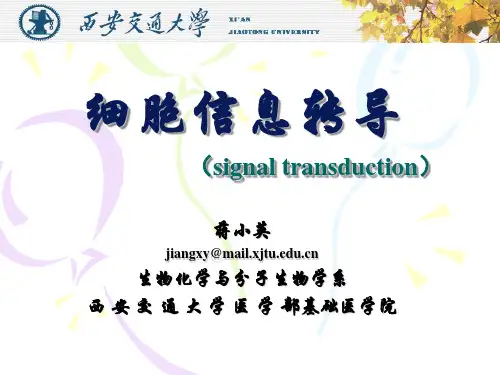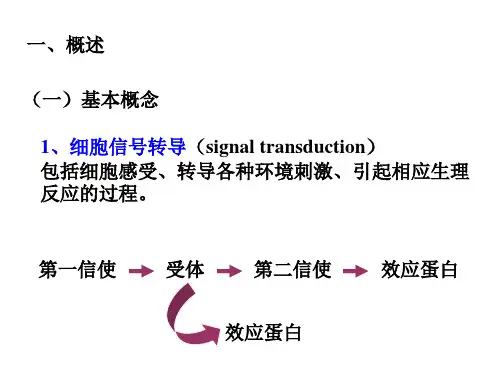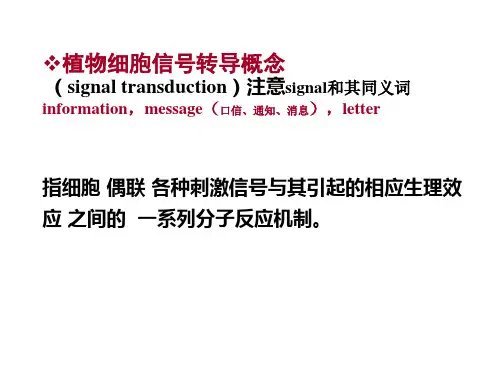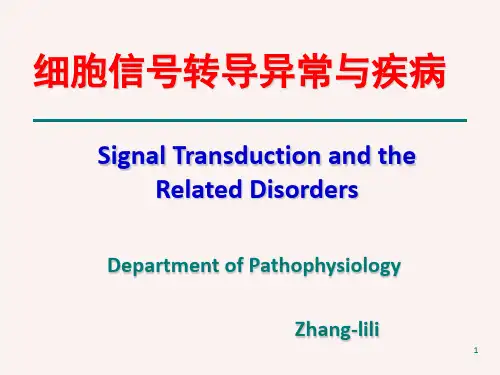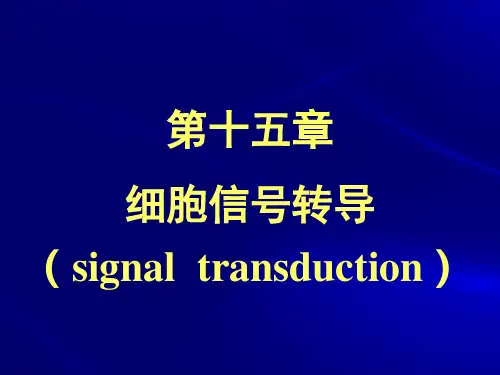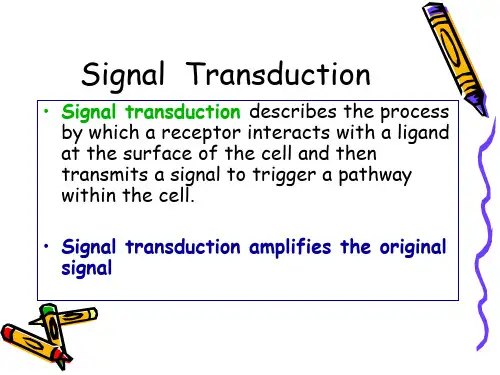- 1、下载文档前请自行甄别文档内容的完整性,平台不提供额外的编辑、内容补充、找答案等附加服务。
- 2、"仅部分预览"的文档,不可在线预览部分如存在完整性等问题,可反馈申请退款(可完整预览的文档不适用该条件!)。
- 3、如文档侵犯您的权益,请联系客服反馈,我们会尽快为您处理(人工客服工作时间:9:00-18:30)。
Effects of signals:
regulate enzyme activity. open / close ion channel in the cell
membrane. regulate gene transcription which ultimately
controls cell metabolism, growth, development and differentiation, etc.
Based on the action manner: 1. Neurotransmitter (acetylcholine,
norepinephrine) 2. Endocrine signals (hormone: insulin, glucagon,
thyroxin, epinephrine, sex hormone) 3. Local chemical messengers or paracrine signals
Receptors on membrane
Receptors in cytosol
II Intracellular signaling molecules
Small molecule Inorganic ion (Ca2+) Lipids (diacylglycerol, DAG) Inositol triphosphate (IP3) Nucleotide (cAMP, cGMP)
Section II Receptors
Proteins (or glycoproteins, glycolipoproteins) On the membrane or inside the cell
Membrane receptor Intracellular receptor Recognize and bind to a specific extracellular signal molecule (ligand) Receptor-ligand induces a cellular response
(growth factor, prostaglandin) 4. Autocrine signal: oncoprotein
Endocrine signals – Signals exert their effects by binding to a cell-
surface receptor and initiating a cascade of signaling events. – Signals that go into the cell, bind to internal receptors, and exert their effects. Steroid hormones, vitamin D, thyroxin All of the intracellular receptors ultimately activate the transcription of regulated genes.
I Membrane receptors 1. Ion-cheurotransmitter
Ach receptor
2. G-Protein coupled receptors (GPCRs)
The largest class of cell surface receptors
The signal transduction of extracellular information
In all multicellular organisms, survival depends on an intercellular communication network that coordinates the growth, differentiation and metabolism of cells in diverse tissues and organs.
ligand: hormones and neurotransmitter Involved in vision, taste, olfaction,
metabolism, transcription, cell proliferation Single polypeptide chain, glycoproteins
Protein (Ras) Substrate enzymes (Jak) Transcription factors
Secondary messenger
Small signaling molecules that are generated in the cell in response to extracellular signals. They can activate many other downstream components. The most important second messengers are: Ca2+, cAMP, cGMP, DAG, IP3, etc.
Section I Signal molecules
Intercellular signaling molecules Intracellular signaling molecules
I Intercellular signaling molecules
Based on the chemical nature: – proteins and peptides (growth factor, insulin) – amino acids and amino acid derivatives (thyroxine, 甲状腺素) – derivatives of fatty acids (prostaglandin, 前列 腺素) – steroids (sex hormone) – small inorganic molecules, nitric oxide (NO), monoxide carbon (CO)



